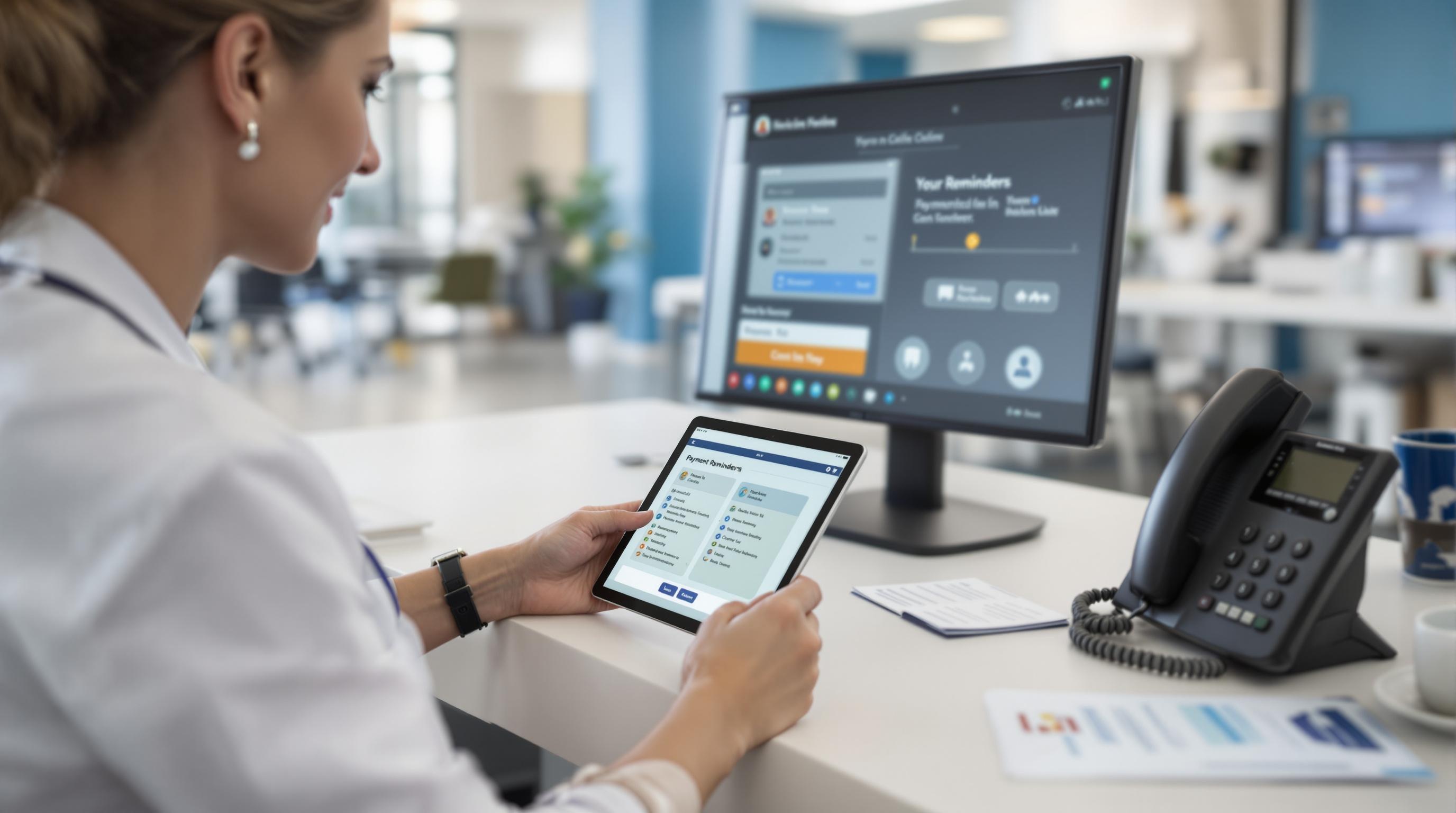Automated COC Calls to Doctors: Boosting Efficiency in SNFs
Discover how automated COC calls to doctors help skilled nursing facilities streamline communication, reduce errors, and enhance patient care outcomes.
Quick Navigation
- 1. Introduction
- 2. Current Challenges in Automated COC Calls To Doctors
- 3. How Sparkco AI Transforms Automated COC Calls To Doctors
- 4. Measurable Benefits and ROI
- 5. Implementation Best Practices
- 6. Real-World Examples
- 7. The Future of Automated COC Calls To Doctors
- 8. Conclusion & Call to Action
1. Introduction
Did you know that artificial intelligence (AI) voice agents are projected to save the healthcare industry up to $600 billion—while transforming the way facilities communicate with physicians? As skilled nursing facilities (SNFs) navigate chronic staffing shortages, rising operational costs, and increasing regulatory demands, the pressure to streamline workflows has never been greater. One critical pain point is the complex process of maintaining continuity of care (COC) through timely communication with doctors. Manual COC calls are time-consuming, prone to errors, and often fall victim to the everyday chaos of understaffed clinical teams.
Fortunately, the rise of automated COC calls powered by AI offers a promising solution. These innovative systems can instantly notify physicians about patient status changes, medication updates, and urgent care needs—without relying on overburdened staff or inefficient phone tag. Not only do automated COC calls save precious time, but they also enhance care quality and regulatory compliance, ensuring no critical details slip through the cracks.
In this article, we’ll explore how automated COC call technology is revolutionizing communication in skilled nursing facilities. We’ll examine current challenges, key benefits, integration best practices, and what leaders should look for in an automated solution. Whether you’re a healthcare administrator, clinician, or IT decision-maker, read on to discover how embracing automation can power better outcomes for both your team and your residents in 2025 and beyond.
2. Current Challenges in Automated COC Calls To Doctors
Automated Continuity of Care (COC) calls are intended to streamline communication between skilled nursing facilities and physicians, ensuring timely updates and adherence to regulatory requirements. However, the implementation of these automated systems introduces a range of operational, compliance, and patient care challenges. Below, we explore the most pressing pain points, supported by real-world data and research.
-
1. High Volume of Unanswered Calls
Automated calls often face low engagement rates. A 2019 survey by the American Medical Association found that physicians routinely ignore up to 30% of calls from automated systems due to alert fatigue and workflow interruptions. This results in delayed responses, compromising both operational efficiency and care coordination.
-
2. Lack of Personalization
Automated COC calls often deliver generic, templated information, which may not address the specific needs of individual patients. According to an NIH study, 62% of physicians reported that automated messages frequently failed to provide contextually relevant clinical details, leading to confusion and additional manual follow-up.
-
3. Disruption to Physician Workflow
Automated calls can interrupt critical clinical tasks, causing workflow inefficiencies. A 2019 HealthIT.gov report found that 70% of physicians felt automated communication technologies increased administrative burden rather than reducing it, ultimately impacting time available for direct patient care.
-
4. Compliance Risks
Regulatory compliance is a major concern. Automated systems must ensure that all required information is conveyed and documented appropriately. Incomplete or improperly logged calls can result in non-compliance with CMS and Joint Commission standards. In 2021, CMS reports cited communication failures as a top reason for skilled nursing facility citations.
-
5. Data Security and Privacy Concerns
Automated calls involve the transmission of sensitive patient data. The HIPAA Journal reports a 25% increase in healthcare data breaches in 2022, with automated communication systems identified as a potential vulnerability if not properly secured.
-
6. Limited Integration with EHR Systems
Many automated COC call solutions lack seamless integration with Electronic Health Records (EHRs). As a result, critical updates may not be reflected in real time, leading to discrepancies and care gaps. According to Health Affairs, 45% of clinicians experience delays in patient data synchronization due to poor system interoperability.
-
7. Negative Impact on Patient Satisfaction
Inefficiencies and miscommunications caused by automated calls can directly affect patient outcomes and satisfaction levels. The Press Ganey 2023 Patient Experience Report noted a 12% drop in patient satisfaction scores in facilities where automated communication tools led to delays or errors in patient care updates.
In summary, while automated COC calls offer potential efficiencies, healthcare facilities must navigate significant challenges related to physician engagement, compliance, workflow disruption, and patient outcomes. Addressing these pain points is critical to harnessing the full benefits of automation while maintaining high standards of care and regulatory compliance.
3. How Sparkco AI Transforms Automated COC Calls To Doctors
Automated Continuity of Care (COC) calls are essential for skilled nursing facilities and healthcare organizations, ensuring that doctors receive timely, accurate information about their patients—especially after hours. However, traditional processes are often manual, time-consuming, and prone to errors or delays. Sparkco AI revolutionizes this critical workflow by leveraging advanced AI and automation, addressing the most common challenges of automated COC calls to doctors.
-
Intelligent Call Routing
Sparkco AI automatically identifies the appropriate physician or on-call provider and routes calls directly to them. This eliminates the risk of misdirected calls, reduces response times, and ensures that urgent messages reach the right doctor without unnecessary delays. -
Automated Documentation and Summaries
The platform transcribes and summarizes every call, generating concise, actionable notes that are instantly accessible. By automating this process, Sparkco AI eliminates manual note-taking errors and enables seamless handoffs between care teams, enhancing patient safety and communication. -
24/7 After-Hours Support
Sparkco AI operates around the clock, handling after-hours calls with the same precision as daytime communications. Its AI-driven system can triage calls, escalate urgent issues, and provide automated responses to routine queries when appropriate—minimizing physician burnout and improving patient satisfaction. -
Real-Time Alerts and Escalation
The system analyzes call content in real time, flagging urgent clinical issues and triggering instant alerts to physicians. This proactive approach ensures that no critical information is missed, and high-priority cases receive immediate attention, even during off-hours. -
Seamless Integration with EHRs and Communication Platforms
Sparkco AI integrates effortlessly with leading Electronic Health Record (EHR) systems and existing communication platforms. This allows for automatic documentation of call interactions within patient records, reducing administrative burden and ensuring regulatory compliance. -
Customizable Workflows and Compliance
The platform offers customizable call routing and escalation protocols, aligning with each facility’s unique policies and compliance requirements. Built-in safeguards help maintain HIPAA compliance, protecting sensitive patient information at every step.
Technical Advantages—Simplified:
Sparkco AI automates repetitive and error-prone tasks, freeing up staff for higher-value responsibilities. Its smart algorithms ensure that the right doctor is notified with accurate, relevant information, while seamless EHR integration keeps patient records up to date. The AI’s ability to analyze and prioritize calls in real time prevents missed communications and reduces clinical risk—without requiring complex technical knowledge from staff.
In summary, Sparkco AI transforms automated COC calls to doctors by delivering speed, accuracy, and reliability. Its intuitive, integrative approach ensures that healthcare teams can focus on delivering exceptional care, confident that critical communications are managed efficiently and securely.
4. Measurable Benefits and ROI
Automated Continuity of Care (COC) calls to doctors are transforming skilled nursing facilities (SNFs) by streamlining communication, enhancing compliance, and improving patient outcomes. Leveraging automation for routine COC calls delivers a quantifiable return on investment (ROI) across multiple operational areas. Below are key data-driven benefits supported by industry research and case studies.
-
Time Savings: Automated COC calls free up significant staff hours. According to a Becker's Hospital Review report, automation can reduce staff time spent on follow-up calls by up to 75%. For a facility making 100 COC calls weekly, this can save nearly 30 staff hours per month.
-
Cost Reduction: Labor cost savings are substantial. A case study by Health IT Outcomes found that automating follow-up calls can save facilities up to $4-6 per call. For a 100-bed SNF, this could equate to an annual savings of $20,000–$30,000 on administrative labor alone.
-
Improved Documentation and Compliance: Automated systems ensure every call is tracked, logged, and timestamped, supporting regulatory compliance. Facilities using automated COC calls have reported a 30% improvement in documentation accuracy (JMIR).
-
Reduced Readmission Rates: Timely, consistent communication with physicians has a direct impact on patient outcomes. One study in The American Journal of Managed Care found that automated follow-up calls can reduce hospital readmissions by 10-15%.
-
Faster Response Times: Automated notifications deliver critical updates to physicians instantly, compared to manual phone trees that can take hours. A NIH study showed average response times dropped from 90 minutes to less than 15 minutes post-automation.
-
Higher Call Completion Rates: Automated calls reach more providers, more reliably. Completion rates with automation exceed 90%, compared to 60-70% for manual calls (JMIR).
-
Patient and Provider Satisfaction: A 2019 study found that 82% of providers preferred automated COC call systems due to reduced interruptions and improved workflow.
-
Consistent Quality and Standardization: Automation eliminates human error and variability, ensuring every COC call follows the same protocol. This standardization contributes to a measurable 20% decrease in communication-related adverse events (Becker's Hospital Review).
As these metrics demonstrate, automated COC calls drive substantial ROI for skilled nursing facilities. By integrating automation, SNFs can enhance care coordination, improve compliance, and achieve significant operational efficiencies.
5. Implementation Best Practices
Successfully deploying automated Continuity of Care (COC) calls to physicians can dramatically improve care transitions, reduce hospital readmissions, and promote timely clinical communication. However, achieving these benefits requires a clear, structured approach. Below are seven actionable steps—each with practical tips and pitfalls to avoid—for skilled nursing facilities and other healthcare providers.
-
Assess Workflow Needs and Objectives
Identify specific care transition scenarios where automated COC calls will be most impactful. Set clear goals (e.g., reducing delays in medication reconciliation or discharge summaries).
Tip: Involve frontline staff in mapping out current processes to pinpoint inefficiencies.
Pitfall: Rushing implementation without understanding existing workflows may lead to poor adoption. -
Select the Right Technology Partner
Choose a solution that integrates with your EHR and can automate call scheduling, documentation, and escalation.
Tip: Look for platforms with proven healthcare compliance (e.g., HIPAA, CMS guidelines).
Pitfall: Overlooking interoperability with existing systems may create data silos. -
Customize Call Scripts and Triggers
Work with clinical teams to develop evidence-based scripts and define triggers (e.g., post-discharge, abnormal labs).
Tip: Make scripts concise and actionable, allowing for personalization when needed.
Pitfall: Using generic or overly complex scripts can frustrate providers and reduce engagement. -
Conduct Pilot Testing
Launch the system with a small, representative group of physicians and patients.
Tip: Gather feedback on call timing, script clarity, and technical glitches.
Pitfall: Skipping the pilot phase can result in widespread issues post-implementation. -
Train Staff and Clinicians
Provide comprehensive training on system use, escalation protocols, and troubleshooting.
Tip: Offer refresher courses and quick reference guides for ongoing support.
Pitfall: Inadequate training can lead to errors and diminished trust in the system. -
Monitor and Optimize Performance
Track key metrics (e.g., call completion rates, physician response times) and regularly review outcomes.
Tip: Set up automated reports and routine check-ins with your technology partner.
Pitfall: Neglecting performance data may allow small problems to escalate. -
Foster Change Management and Communication
Engage clinicians early, address concerns, and highlight the benefits of automated COC calls for patient










